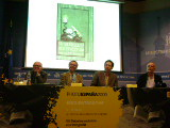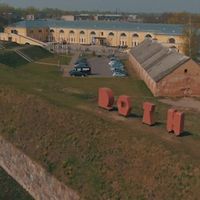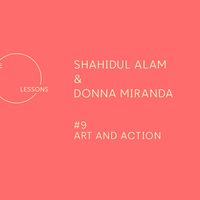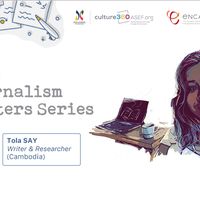Words and photo: literature and photography


Jerneja Rebernak, Project Officer Cultural Exchange Department, was in Madrid from 4 to 6 June 2009 for the VII edition Encuentros Photo España - Discussions on photography. She reported for us on culture360.org.
"There is a tension in photography when we tend to present reality, and it traps the reality of being". (Philippe Ortel)
In an attempt to bring forward reflections about the relationship of photography and literature, the symposium Encutentros Photo España, highlighted the influence of photography in modern literature, and their impact on the reproduction of history and memory. Recognized as a young discipline, the symposium deconstructed theories of subjectivity and presented essences about the interconnectivity of photography and literature in our time. Hosted by the renowned photographer Ferdinando Scianna and writer Antonio Anson, influential scholars and writers like Federico Campbell, Paul Edwards, Philippe Ortel, Claude Ambroise, Marianne Hirsch and many more, discussed and clarified the impact of the photography on literature and vice-versa.
Antonio Anson historicized the relationship between the two disciplines matching academic cross disciplinary endeavours and enabling an in-depth analysis which offered a fertile ground for critical discourse, representation and identity theories. As described in the book by Jonathan Crary “Techniques of the observer”, early photographic reports resulted as a manifestation of archaeological projects, thus enabling a conquering view of the world. Mainly taken by western explorers, these photographs generated a very political view of the world. In those images, objects of the real world were slowly transformed in intention-oriented objects, becoming an inseparable part of our shared perspective of history.
Leading away from the technological and scientific reality and provoking a new vision of the world - artistic photography – is indeed a new notion in itself. As a matter of fact, artistic photography and technological advancement that shaped our contemporary culture has only emerged in the last decades. The demarcation of this historical passage lies in the famous encounter with theory reflected in Man Ray’s aesthetic idea of photography where he declared that: “Beauty is a random encounter of two unrelated objects placed in a random environment.” On the other hand literature is by default imagination incorporated and processed into fiction. Modernist literary works of Baudelaire, Proust, Aloysius Bertrand, Margarite Duras and William Faulkner, to name just a few, had lead the path for this conceptual encounter, their poetic material enabling a recreation of imaginary realities, which made possible to turn anything into an image.
The professor at the University of Toulouse, Philip Ortel opened a Pandora’s box on the influence of photography on French culture through the writings of Roland Barthes. He mentioned that the book by Barthes “Camera Lucida: Reflections on Photography” became an important historical reference, not only recognizing photography as a creative practice – as an art in time - but also determining a new mode of observation of photography, thus revitalising theory. It is the subjective experience of photography which established a challenge to the representation of history. Ortel went further into his disclosure about the connection of photography when he opened his perspective on autobiographical photography. This type of photography aims to retain the identity of past events, becoming an almost impossible task in the light of Barthes understanding of photography. Therefore, he argued that pictures never represent what actually happens, what they fail to show is the existence of an invention rooted in its own time, showing correlations of technology and the implication and impact on culture and history. The fact that widespread access to multimedia formats equals all representation tools at once, could well highlight the notion of how the virtualization of the image and its meanings can be perceived as perishable truth. In this perspective, Ortel’s presentation ended towards future recommendations for a critical outlook on methodologies of representation: “We receive signs in an equivalent form and future artists will have to come up with new devices to show their particularity.”
In relation to this principles of photography and its theory, Mexican writer Federico Campbell, characterized the language of photography differently from that of the narrator, where the latter is the one that truly “challenges the progression of language” highlighting that photography has its own inherited technical language. He opened the questions of time by mentioning that “photography is the static portrayal of immortality” and that a merging occurs between time and space within photographs. In reference to memory he made an explicit antagonism between words and photography, where the latter consolidates memory and the first one reflects it.
Campbell credits the Argentinean writer Julio Cortázar in his novel “The Devil's Drool” and explains how the enacting of the film based on his work, Antonioni’s “Blow up”, questioned the illusive aspect of reality – the familiar shapes of the world seen through the photograph. In the story, the act of taking and enlarging photographs becomes a display, an illusion of certainty, thus pinpointing the limitations of its own perspective. Campbell explicitly said that he mistrusts the idea of photographic fiction – “photography itself is part of fiction,” he says. However, history uses photography to try to explain human kind, somehow trying to find its own aesthetic reality. Campbell also made reference to the novel “Catcher in the Rye”, by J.D. Salinger, in which photography plays a descriptive narrative role in the text. He says that: “by utilising photography in the narrative, the author draws imaginary relationships of desire and fear, leaving the camera to become an intermediary to this process.”
The reflections of the authors - their quest for the science of the invisible and psychological realms of being, made this symposium a timely event where interdisciplinary research impacted discussions. To comprehend in its totality the intertwined characteristics that may or may not link both art forms and for more references on the examples mentioned in this article, a book has been published and made available at the Ministry of culture website.
Similar content
deadline
10 Mar 2020
posted on
09 Mar 2017
deadline
08 May 2015
from - to
06 Nov 2015 - 17 Jan 2016
from - to
15 Nov 2021 - 15 Nov 2021
By Tola SAY
02 Mar 2023






